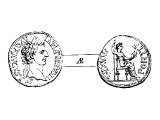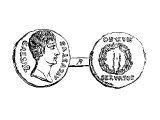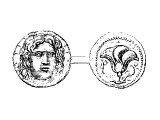
Denarius
Denarius, of Tiberius. A silver coin, also called a Dinar, or Drachma. . Left: TIberius Caesar, Son of his late Majesty Augustus (and himself) Augustus&`;, protrait of Tiberius. Right: &`;Pontifex Maximus&`;, Empress Dowager Livia with scepter and olive branch. Tiberius issued only one type of Denarius, sothis is most probably the coin shown to Jesus. Mt.22.17-21, Mk.12.14-17, Lk.20.21-25. This was a normal day&`;s wage for a labourer.
|

Denarius
Denarius of Augustus. The Denarius was theoretically worth a little less than a drachma, but in practice they were equivalent..
|

Denarius
Denarius, silver, c 132 BC. Left: &`;Rome&`;, and &`;*&`; indicating it is worth 10 copper coins, helmeted head of Minerva, goddess of Rome. . Right: &`;Titus DEIDIus&`; (probably a proconsul), Roman soldier with shield, short sword and flagellum fighting an adversary with sheild, dagger and stick, worth 10 copper coins
|

Didrachma
Didrachma, silver, (worth two drachmas or half a Shekel), the value of the Temple Tax - cf Mt.17.24. Traditionally this is the coin of the 30 pieces of silver - cf Mt.26.15, but this would not add up to the 30 Shekels of Ex.21.32. . This coin is from Rhodes, of the the few countries which produced a didrachma. Left: face of Helios, the Sun god. Right: &`;of Rhodes&`;, &`;Akesis&`; (a magistrate?), a rose, Apollo and a lyre.
|